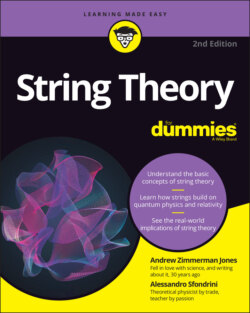Читать книгу String Theory For Dummies - Andrew Zimmerman Jones - Страница 13
Using tiny and huge concepts to create a theory of everything
ОглавлениеString theory is a type of high-energy theoretical physics, practiced largely by particle physicists. It’s an evolution of quantum field theory (see the sidebar “What is quantum field theory?”), which is the current framework that describes the particles and forces in our universe (except gravity). String theory famously predicts that the universe should have more spatial dimensions than the three we observe. It also shows that, in principle, the extra dimensions within the theory can be wrapped up into a very small size (a process called compactification) in a way that reproduces fundamental particles like the photon or the electron. This is the power of string theory — using the fundamental strings, and the way extra dimensions are compactified, to provide a unified description of all the particles and forces known to modern physics.
Among the forces that need to be described is, of course, gravity. Superficially, gravity has been the simplest force for humans to grasp since the time of Galileo. There is, however, more than meets the eye, as Einstein discovered: Gravity is a theory of the geometry of space and time. For this reason, it’s notoriously hard to marry the ideas of quantum physics with gravity. String theory does incorporate both gravity and quantum physics in a natural way. You can even say that string theory is a theory of quantum gravity because it’s impossible to construct any string theory without gravity.
Still, not every aspect of gravity is understood from string theory. Importantly, the established theory of gravity, general relativity, has a fluid, dynamic space-time, and one aspect of string theory that’s still being worked on is getting that type of space-time to emerge out of the theory.
The major achievements of string theory are concepts you can’t see, unless you know how to interpret the physics equations. String theory deals with rather extreme amounts of energy; that’s why it’s hard to test its predictions directly with experiments. Yet it has revealed profound mathematical relationships within the equations, which leads physicists to believe that they must be true. We discuss these properties and relationships — known by jargon that describes various symmetries and dualities, the cancellation of anomalies, and the explanation of black hole entropy — in Chapters 10 and 11.
In recent years, there has been much public debate over string theory, waged within newsrooms and across the internet. We address these issues in Part 5, but they come down to fundamental questions about how science should be pursued. String theorists believe that their methods are sound, while the critics believe they’re questionable because they stray too far from contact with experimentation — the true core of physics. Time, and experimental evidence, will tell which side has made the better argument.
